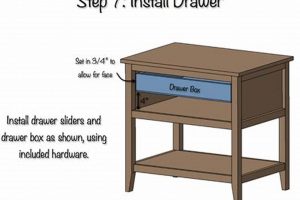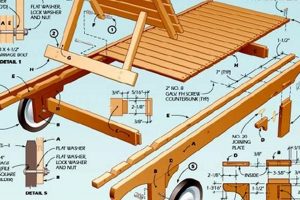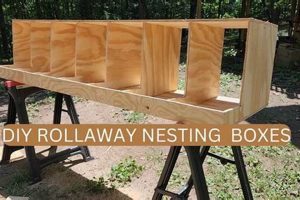Creating custom storage solutions for lavatory areas through self-directed construction represents a cost-effective and personalized approach to home improvement. This process typically involves designing and building a support structure for a sink, often incorporating storage space, using readily available materials and tools. A common example is constructing a cabinet from reclaimed wood to house a sink and provide shelving for toiletries.
The significance of these projects lies in their ability to tailor a bathroom’s functionality and aesthetics to specific needs and preferences. Benefits range from significant cost savings compared to purchasing pre-made units, to the environmental advantages of using recycled materials. Historically, this approach reflects a tradition of resourcefulness and craftsmanship, allowing homeowners to adapt their living spaces to evolving requirements.
The following sections will explore essential considerations for embarking on such a project, encompassing design principles, material selection, construction techniques, and finishing options, providing a framework for a successful outcome.
Essential Guidance for Lavatory Cabinet Construction
The subsequent guidelines address critical aspects to consider when developing personalized storage solutions for sink areas, aimed at ensuring both functionality and aesthetic appeal.
Tip 1: Precise Measurement is Paramount: Accurate measurements of the available space are crucial. Account for plumbing locations and door swing clearances to avoid costly errors and rework during construction.
Tip 2: Prioritize Material Selection: Choose materials resistant to moisture and humidity, such as treated lumber, marine-grade plywood, or solid surface composites. Consider the aesthetic qualities and durability of each material in relation to the bathroom’s overall design.
Tip 3: Develop a Detailed Plan: Create a comprehensive design schematic, including dimensions, joinery methods, and hardware placement. This will serve as a roadmap throughout the construction process.
Tip 4: Emphasize Structural Integrity: Employ robust joinery techniques, such as mortise and tenon, dovetail, or pocket-hole screws, to ensure the unit’s stability and longevity. Reinforce corners and stress points to prevent sagging or warping.
Tip 5: Consider Plumbing Accessibility: Design the structure to allow easy access to plumbing connections for future repairs or modifications. Incorporate removable panels or access ports as needed.
Tip 6: Select Appropriate Hardware: Choose corrosion-resistant hardware, such as stainless steel or brass, for hinges, drawer slides, and pulls. Ensure hardware is appropriately sized and rated for the intended use.
Tip 7: Implement a Durable Finish: Apply a high-quality sealant or finish to protect the wood from moisture damage. Consider using a water-based polyurethane or epoxy resin for enhanced durability and water resistance.
Adhering to these principles enhances the likelihood of creating a durable, functional, and aesthetically pleasing custom storage solution, tailored to the specific requirements of the lavatory area.
The following sections will delve into advanced design concepts and customization options, empowering the reader to create a truly unique and personalized bathroom feature.
1. Precise Measurements
Accuracy in dimensional assessment is paramount in the successful execution of self-directed lavatory cabinet construction. Discrepancies, however minute, can compromise the final product’s functionality, aesthetics, and structural soundness.
- Spatial Confinement
Bathroom dimensions often present physical limitations. Imprecise measurements lead to the creation of structures that fail to integrate seamlessly within the allocated area. For example, a cabinet exceeding specified width parameters obstructs access to adjacent fixtures or impedes door swing, necessitating costly modifications or complete reconstruction.
- Plumbing Integration
Lavatory construction invariably requires accommodating existing plumbing infrastructure. Inaccurate measurements relating to pipe placement, drain height, and water supply lines hinder proper sink installation. Misalignment of these elements may result in leaks, reduced water pressure, or the inability to connect fixtures securely.
- Component Alignment
A self-constructed cabinet comprises multiple individual components, including doors, drawers, shelves, and supporting structures. Inaccurate measurements during the cutting and assembly phases introduce cumulative errors, resulting in misaligned components, uneven gaps, and reduced structural integrity. Doors that fail to close properly or drawers that bind exemplify this issue.
- Material Optimization
Accurate dimensional planning minimizes material waste and optimizes resource utilization. Imprecise measurements lead to overestimation of required material quantities or render cut pieces unusable. This results in increased project costs and potential environmental consequences associated with discarding surplus materials.
In summary, meticulous attention to dimensional precision is foundational in the process of self-directed lavatory construction. Accurate measurements mitigate spatial constraints, facilitate seamless plumbing integration, ensure proper component alignment, and promote efficient material utilization. Neglecting this critical aspect introduces avoidable complications and compromises the overall success of the endeavor.
2. Material Durability
The longevity and performance of a self-constructed lavatory cabinet are inextricably linked to the inherent properties of the materials employed. Bathroom environments, characterized by elevated humidity and frequent exposure to moisture, necessitate materials capable of withstanding these conditions without degradation. The selection of inappropriate materials directly impacts the structural integrity, aesthetic appeal, and overall lifespan of the completed unit. For instance, using untreated, non-moisture-resistant particleboard in a cabinet beneath a sink will inevitably lead to swelling, delamination, and eventual structural failure, rendering the project unsustainable.
Material durability directly influences maintenance requirements and long-term cost-effectiveness. Investing in materials resistant to moisture, mold, and mildew translates to reduced maintenance efforts and prolonged periods between replacements or repairs. Consider the example of a solid wood cabinet constructed from a species like teak or cedar. While the initial investment might be higher compared to cheaper alternatives, the natural oils and inherent water resistance of these woods provide superior protection against moisture damage, significantly extending the cabinet’s lifespan and minimizing the need for frequent maintenance. This long-term benefit offsets the initial higher cost.
In summation, the selection of durable materials is a foundational aspect of any lavatory cabinet construction endeavor. This choice has a direct bearing on the project’s sustainability, maintenance demands, and overall cost. Prioritizing moisture resistance, structural integrity, and resistance to biological degradation ensures the creation of a long-lasting and functional bathroom fixture, aligning with the principles of responsible and effective home improvement.
3. Structural Integrity
Structural integrity is a non-negotiable attribute in self-directed lavatory cabinet design and construction. It directly dictates the stability, load-bearing capacity, and overall longevity of the finished unit. A compromised structure poses a safety hazard, potentially leading to collapse under the weight of a sink, countertop, or stored items. This, in turn, results in property damage, personal injury, and the need for costly repairs or replacements. For example, a cabinet frame constructed with inadequate joinery or undersized lumber may buckle or sag over time, especially when supporting a heavy countertop material like granite or concrete.
The choice of materials, joinery methods, and load distribution techniques directly influence structural robustness. Solid wood or high-quality plywood provides greater stability compared to cheaper, less dense alternatives like particleboard or MDF. Employing robust joinery methods, such as mortise and tenon, dovetails, or reinforced pocket-hole screws, significantly enhances the cabinet’s ability to withstand stress and maintain its shape over time. Careful consideration of load distribution is also crucial. Designing the cabinet with sufficient support members strategically positioned beneath the countertop and sink basin ensures that the weight is evenly distributed, minimizing the risk of localized stress and potential failure. A common mistake is neglecting to provide adequate support directly beneath the sink, leading to cracking of the countertop or sagging of the cabinet.
In summary, structural integrity is a foundational element of successful lavatory cabinet construction. It directly impacts safety, longevity, and overall value. Prioritizing material selection, joinery techniques, and load distribution ensures the creation of a durable and reliable cabinet that withstands the demands of daily use for years to come. Compromising on structural integrity inevitably leads to diminished functionality, increased maintenance costs, and potential safety hazards, underscoring the importance of meticulous planning and execution throughout the construction process.
4. Plumbing accessibility
The element of plumbing accessibility occupies a critical position in the realm of self-directed lavatory cabinet design and construction. The creation of visually appealing and structurally sound cabinets is rendered incomplete without adequate consideration for the placement, maintenance, and potential modification of existing and future plumbing systems. Omission of this crucial factor generates substantial downstream consequences, ranging from increased repair costs to complete reconstruction of the unit. For instance, a cabinet built without access panels surrounding water supply shut-off valves necessitates the removal of the entire cabinet structure in the event of a minor leak, a scenario that could have been averted through thoughtful design.
Practical application of plumbing accessibility principles dictates the incorporation of removable panels, strategically positioned access ports, and thoughtfully planned open spaces within the cabinet’s design. These design elements enable convenient access to pipes, drains, and shut-off valves without compromising the cabinet’s aesthetic appeal. The employment of quick-connect fittings and flexible supply lines, in contrast to rigid pipe connections, further facilitates ease of access during repairs or modifications. An additional consideration lies in the future-proofing of plumbing systems. Incorporating slightly oversized access points anticipates the need for potential upgrades or modifications to plumbing configurations, precluding the need for extensive structural alterations in the long term.
In summary, the correlation between self-directed lavatory cabinet construction and plumbing accessibility is inseparable. Attending to plumbing accessibility throughout the design and construction phases enhances the unit’s long-term functionality, reduces maintenance expenditures, and preempts potentially disruptive and costly repairs. This proactive approach aligns with responsible and efficient home improvement practices, ensuring a durable and adaptable bathroom fixture.
5. Hardware Selection
Appropriate hardware selection constitutes a crucial determinant in the overall functionality, durability, and aesthetic coherence of self-constructed lavatory cabinets. Selection extends beyond mere decorative considerations, impacting structural integrity, operational efficiency, and long-term performance.
- Hinge Mechanisms
Hinge mechanisms govern door operation, affecting ease of access and cabinet aesthetics. Corrosion-resistant materials, such as stainless steel or brass, are essential in humid bathroom environments to prevent rust and maintain smooth operation. Soft-close hinges, while more expensive, enhance user experience by preventing slamming and reducing wear on the cabinet frame. The choice of hinge type (e.g., concealed, face-frame, or overlay) dictates installation methods and the cabinet’s overall visual profile.
- Drawer Slides
Drawer slides facilitate smooth and reliable drawer operation. Ball-bearing slides offer superior load-bearing capacity and durability compared to friction-based slides. Full-extension slides maximize drawer access, while undermount slides provide a cleaner aesthetic by concealing the hardware. Drawer slide selection must align with the drawer’s dimensions, weight capacity requirements, and desired functionality.
- Knobs and Pulls
Knobs and pulls serve both functional and decorative purposes. Ergonomic design considerations are paramount, ensuring comfortable grip and ease of use. Material selection should complement the cabinet’s overall style and withstand repeated handling. Secure attachment is critical to prevent loosening or breakage over time. The choice of finish (e.g., brushed nickel, chrome, or oil-rubbed bronze) influences the cabinet’s aesthetic and should coordinate with other bathroom fixtures.
- Fasteners
Fasteners, including screws, bolts, and adhesives, are essential for structural integrity. Corrosion-resistant fasteners are mandatory in bathroom environments to prevent rust and maintain secure connections. Screw length and diameter must be appropriate for the materials being joined. The use of wood glue in conjunction with screws enhances joint strength and prevents loosening over time. Inadequate fastener selection can compromise structural stability and lead to premature cabinet failure.
Strategic hardware selection, therefore, represents an integral facet of successful self-directed lavatory cabinet construction. Thoughtful consideration of material properties, operational characteristics, and aesthetic alignment ensures the creation of a functional, durable, and visually cohesive unit that complements the bathroom’s overall design scheme.
6. Protective finishing
Protective finishing is an indispensable component of self-executed lavatory cabinet projects, exerting a direct influence on longevity, aesthetic preservation, and resistance to environmental stressors. The bathroom environment, characterized by elevated humidity levels and frequent water exposure, presents a significant challenge to wooden structures. Without a robust protective layer, wood substrates are susceptible to moisture absorption, leading to swelling, warping, fungal growth, and eventual structural degradation. Consequently, the meticulous application of a suitable finish is not merely an aesthetic enhancement but a critical safeguard against premature deterioration. For instance, a cabinet constructed from untreated wood in a high-humidity bathroom will exhibit signs of water damage within a relatively short timeframe, requiring costly repairs or complete replacement, thereby negating the cost savings initially achieved through self-construction.
The selection of an appropriate protective finish hinges on factors such as the type of wood utilized, the cabinet’s anticipated usage, and the desired aesthetic outcome. Oil-based finishes, such as varnishes and polyurethanes, offer excellent water resistance and durability, forming a resilient barrier against moisture penetration. Water-based finishes, while generally less durable, exhibit lower VOC emissions and facilitate easier cleanup. Epoxy resins provide exceptional water impermeability and chemical resistance, making them suitable for demanding applications. Proper surface preparation, including thorough sanding and cleaning, is crucial for optimal finish adhesion and performance. Multiple coats of finish, applied according to the manufacturer’s instructions, enhance protection and improve aesthetic appeal. A practical application involves applying a marine-grade varnish to cabinets located near showers or bathtubs, providing enhanced protection against persistent moisture exposure.
In conclusion, protective finishing represents a vital step in self-directed lavatory cabinet projects, directly impacting long-term durability and overall value. A properly applied finish safeguards against moisture damage, preserves aesthetic integrity, and extends the lifespan of the cabinet. Neglecting this critical aspect compromises the investment and necessitates future repairs or replacements. Therefore, meticulous attention to finish selection and application techniques is essential for ensuring the successful and sustainable outcome of any self-constructed lavatory cabinet endeavor.
Frequently Asked Questions
The following addresses frequently encountered queries pertaining to the design, construction, and implementation of custom lavatory cabinet solutions.
Question 1: What constitutes the most appropriate lumber for lavatory cabinet construction, considering moisture exposure?
The selection of moisture-resistant lumber is paramount. Options include treated lumber, marine-grade plywood, cedar, or teak. These materials exhibit inherent resistance to water damage, extending the cabinet’s lifespan in humid environments. Untreated lumber is generally unsuitable due to its susceptibility to warping and rot.
Question 2: How does one ensure adequate plumbing accessibility within a self-constructed lavatory cabinet?
Plumbing accessibility necessitates the incorporation of strategically placed access panels or removable sections within the cabinet’s design. These provisions enable convenient access to shut-off valves, drainpipes, and supply lines for maintenance or repairs without requiring complete cabinet disassembly.
Question 3: What joinery techniques are recommended to ensure robust structural integrity in a self-constructed lavatory cabinet?
Robust structural integrity is achieved through the application of advanced joinery techniques. Mortise and tenon joints, dovetail joints, and reinforced pocket-hole screws provide superior strength and stability compared to simple butt joints. Adequate bracing and reinforcement at stress points are also crucial.
Question 4: What type of finish should be applied to a self-constructed lavatory cabinet to protect against moisture damage?
The application of a moisture-resistant finish is essential for safeguarding the wood substrate. Oil-based varnishes, polyurethanes, and epoxy resins provide excellent protection against water penetration. Multiple coats, applied according to the manufacturer’s instructions, enhance durability and aesthetic appeal. Proper surface preparation is critical for optimal finish adhesion.
Question 5: How can accurate measurements be obtained to ensure a proper fit of a self-constructed lavatory cabinet within a bathroom space?
Accurate measurements necessitate the utilization of precision measuring tools and a systematic approach. Account for plumbing locations, wall irregularities, and door swing clearances. Multiple measurements should be taken and verified to minimize errors. Creating a detailed scale drawing aids in visualizing the cabinet’s dimensions and spatial relationships.
Question 6: What safety precautions should be observed when undertaking a self-directed lavatory cabinet construction project?
Adherence to established safety protocols is paramount. Wear appropriate personal protective equipment, including safety glasses, gloves, and a dust mask. Utilize power tools responsibly and in accordance with the manufacturer’s instructions. Ensure adequate ventilation when working with finishes or adhesives. Consult local building codes and regulations to ensure compliance.
Careful planning, material selection, and execution are crucial for a successful self-directed lavatory cabinet project.
The next section provides a list of resources to use when planning and building lavatory cabinets.
Conclusion
The preceding examination of “diy bathroom vanity plans” has underscored the importance of precise measurement, material durability, structural integrity, plumbing accessibility, appropriate hardware, and protective finishing. These elements, when meticulously addressed, determine the functionality, longevity, and aesthetic merit of self-constructed lavatory cabinets. The detailed analysis of each factor reinforces the necessity for rigorous planning and execution.
Mastery of these principles equips individuals to embark on lavatory cabinet projects with confidence, minimizing potential setbacks and maximizing the likelihood of a successful outcome. Continual adherence to safety standards and diligent observation of established building codes are non-negotiable components of responsible craftsmanship. The pursuit of knowledge and skill refinement remains a perpetual imperative for those engaging in self-directed home improvement endeavors.







